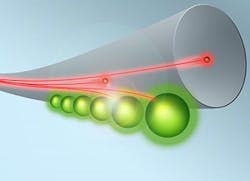Atom-coupled optical fiber slows light to 180 km per hour
A team of scientists at the Vienna University of Technology (TU Wien; Vienna, Austria) has demonstrated that light can be slowed down in an optical fiber. By coupling atoms to glass fibers light was slowed down to a speed of 180 km/h. The team even managed to bring the light to a complete stop and to retrieve it again later. This technology is an important prerequisite for a future glass-fiber-based quantum Internet, in which quantum information can be teleported over great distances.
RELATED ARTICLE: Laser radar steers beam using slow light
In a vacuum, the speed of light is always the same—approximately 300 million meters per second. When light is sent through a medium such as glass or water, it is slowed down a little bit due to its interaction with the material. "In our system, this effect is extreme, because we are creating an exceedingly strong interaction between light and matter," says TU Wien professor Arno Rauschenbeutel. "The speed of light in our glass fiber is only 180 kilometers per hour. Any express train can top that."
"There are different ways of quantum mechanically transferring information", says Clément Sayrin. "Glass fiber technology is a particularly attractive option--after all, a worldwide glass fiber net already exists, and we are already using it to transmit data."
At the TU Wien, cesium atoms are coupled to an ultrathin glass fiber. When the atom absorbs laser light it can pass from a state of low energy to a state of higher energy—provided that the energy of the absorbed photon matches the energy difference between the two states. This light, however, cannot be retrieved in a controlled way.
That is why the Viennese team used an additional control-laser in their experiment, which couples the high-energy state to a third atomic state. "The interplay between these three quantum states prevents the photon from just being absorbed and randomly emitted. Instead, the photon's quantum information is transferred to an ensemble of atoms in a controlled way, and it can be stored there for some time." The photon is turned into a collective excitation of atoms.
After two microseconds, a period of time in which the light would normally have traveled about half a kilometer, the control laser was used to prompt the atoms to emit the light back into the glass fiber. The properties of the photon stay exactly the same—an important prerequisite for quantum communication. "Quantum physics allows us to create a connection between sender and receiver, which makes eavesdropping impossible," says Rauschenbeutel. "The fundamental laws of quantum physics make sure that no one can tap the connection without being noticed."
SOURCE: TU Wien via R&D Magazine; http://www.rdmag.com/news/2015/04/glass-fiber-brings-light-standstill
About the Author

Gail Overton
Senior Editor (2004-2020)
Gail has more than 30 years of engineering, marketing, product management, and editorial experience in the photonics and optical communications industry. Before joining the staff at Laser Focus World in 2004, she held many product management and product marketing roles in the fiber-optics industry, most notably at Hughes (El Segundo, CA), GTE Labs (Waltham, MA), Corning (Corning, NY), Photon Kinetics (Beaverton, OR), and Newport Corporation (Irvine, CA). During her marketing career, Gail published articles in WDM Solutions and Sensors magazine and traveled internationally to conduct product and sales training. Gail received her BS degree in physics, with an emphasis in optics, from San Diego State University in San Diego, CA in May 1986.
